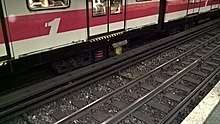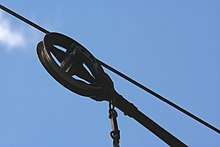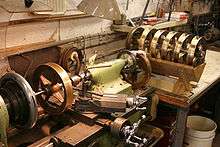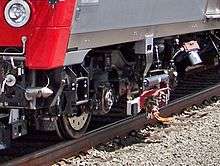Current collector
Electric current collectors are used by trolleybuses, trams, electric locomotives or EMUs to carry electrical power from overhead lines or electrical third rails to the electrical equipment of the vehicles. Those for overhead wires are roof-mounted devices, those for third rails are mounted on the bogies.
Typically, they have one or more spring-loaded arms that press a collector or contact shoe against the rail or overhead wire. As the vehicle moves, the contact shoe slides along the wire or rail to draw the electricity needed to run the vehicle's motor.
The current collector arms are electrically conductive but mounted insulated on the vehicle's roof, side or base. An insulated cable connects the collector with the switch, transformer or motor. The steel rails of the tracks act as the electrical return.
Electric vehicles that collect their current from an overhead line system use different forms of one- or two-arm pantograph collectors, bow collectors or trolley poles. The current collection device presses against the underside of the lowest wire of an overhead line system, which is called a contact wire.
Most overhead supply systems are either DC or single phase AC, using a single wire with return through the grounded running rails. Three phase AC systems use a pair of overhead wires, and paired trolley poles.
Bow Collector
Contact shoe

Electric railways with third rails, or fourth rails, carry collector or contact shoes projecting laterally (sideways), or vertically, from their bogies. The contact shoe may slide on top of the third rail (top running), on the bottom (bottom running) or on the side (side running). The side running contact shoe is used against the guide bars on rubber-tired metros. A vertical contact shoe is used on ground-level power supply systems, stud contact systems and fourth rail systems. A pair of contact shoes was used on underground current collection systems. The contact shoe on a stud contact system is called a ski collector. The ski collector moves vertically to accommodate slight variations in the height of the studs. Contact shoes may also be used on overhead conductor rails, on guide bars or on trolley wires in the case of trams or trolleybuses. Most railways use three rails, while the London Underground uses four rails. Trams or trolleybuses use a grooved trolley shoe at the end of a trolley pole.
Trolley pole wheel

The trolley pole wheel is a grooved contact wheel mounted on top of the trolley pole instead of a trolley shoe. The trolley pole wheel somewhat resembles a pulley. Trolley pole wheels are now rarely used.
Trolley pole
Collector pole
A collector pole is the pole at the end of a bumper car. It has a contact shoe on top.
Electric cranes
Electric overhead cranes and gantry cranes may use a current collector system to provide power over the full length of their operating area. The current collector assembly use sliding shoes that run on rails. Depending on the size of crane, contact rails may be copper wires, copper bars, or steel channels. mounted on insulating supports. Two rails are used for DC supply, and three for three-phase AC, with grounding of the crane through contact with the runway rails. The contact rails are mounted out of the reach of people working in the area to prevent an electric shock hazard.
Gallery
 Chicago Transit Authority third rail contact shoe of Chicago 'L' car
Chicago Transit Authority third rail contact shoe of Chicago 'L' car Modern one-arm “pantograph” collector with double collector shoes
Modern one-arm “pantograph” collector with double collector shoes Collector (contact) shoe for a top contact third rail
Collector (contact) shoe for a top contact third rail
 A bow collector on a small electric locomotive
A bow collector on a small electric locomotive A trolleybus with a pair of trolley poles on the roof.
A trolleybus with a pair of trolley poles on the roof.
 Bumper cars at Taunus Wunderland showing collector poles.
Bumper cars at Taunus Wunderland showing collector poles..jpg) 1882: The first trolleybus in the world by Siemens
1882: The first trolleybus in the world by Siemens Machining spare trolley pole wheels. The six on the right appear to be finished
Machining spare trolley pole wheels. The six on the right appear to be finished A trolley pole on a streetcar of the Toronto streetcar system
A trolley pole on a streetcar of the Toronto streetcar system Dual mode contact shoe on Metro-North M8 railcar, designed for both over- and under-running third rail[1].
Dual mode contact shoe on Metro-North M8 railcar, designed for both over- and under-running third rail[1]. Siemens-Split overhead line, an unusual current collector and a ground, at the International Exposition of Electricity in Paris
Siemens-Split overhead line, an unusual current collector and a ground, at the International Exposition of Electricity in Paris
See also
References
- "Third-rail current collectors". www.schunk-carbontechnology.com.